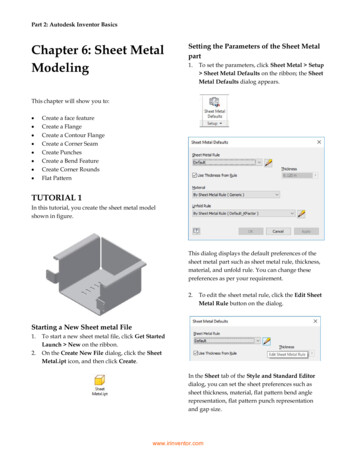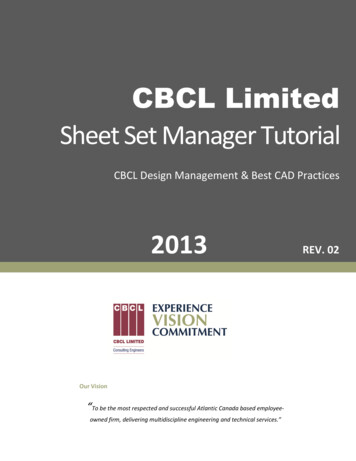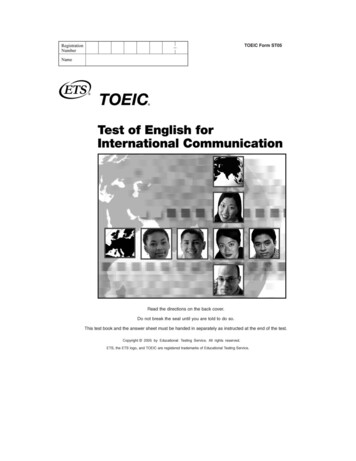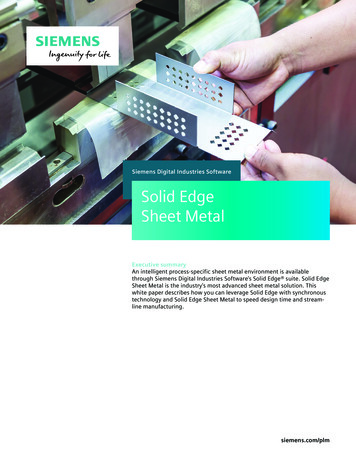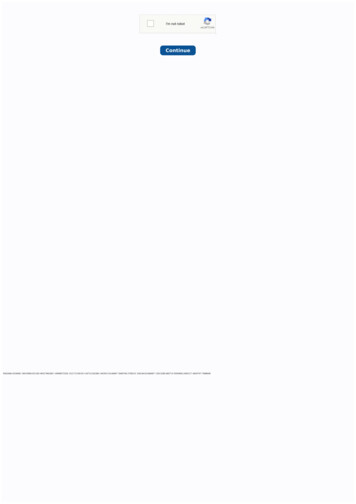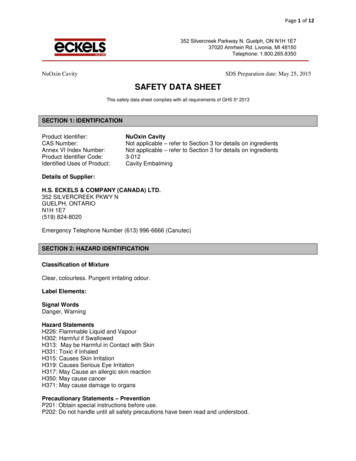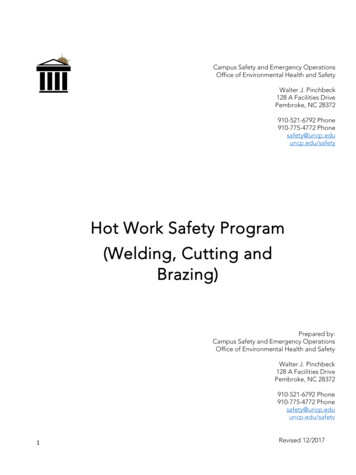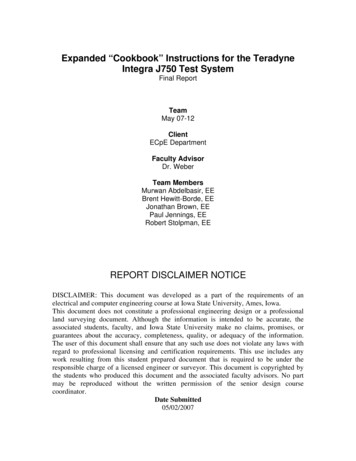
Transcription
Safety Data Sheet: 90-10 Copper Nickel AlloySection 1: Product IdentificationRecommended Use and Restrictions:Solid copper, copper alloys, various forms and uses.Manufacture of articles.Manufacturer/Supplier:Wolverine Tube, Inc.2100 Market Street NEDecatur, AL 35601(800) 633-3972Emergency Information:CHEMTREC (24HR Emergency Telephone), call:1-800-424-9300International CHEMTREC, call: 1-703-527-3887GHS Product Identifier: 90-10 Copper-Nickel AlloySection 2: Hazard IdentificationClassification: Copper and copper alloys are considered an “article” and are not hazardous in its solid form.However, certain processes such as cutting, milling, grinding, melting and welding could result in some serioushazardous materials being emitted. The GHS classification below pertains to these emitted products during theseprocesses.Signal Word, Hazard Statements & Symbols: DANGERSymbolsN/AHazardGHS ClassificationHazard StatementsSuspected carcinogen. Nickel is suspected ofcausing cancer of the lungs and nasalcavities.Nickel may cause allergy or asthmasymptoms or breathing difficulties if inhaled.May cause genetic effects.Copper may cause damage to lungs, bloodand kidneys through prolonged or repeatedexposure.CarcinogenicityCategory – 2Respiratory SensitizerCategory – 1Toxic to ReproductionCategory – 1BSTOT (repeated exposure)Category – 1Skin SensitizerCategory – 1Nickel may cause allergic skin reaction.Acute Toxic to Aquatic LifeCategory – 1Very toxic to aquatic life.Chronic Toxic to Aquatic LifeCategory – 1Very toxic to aquatic life with long lastingeffects.Eye IrritationCategory – 2BCauses eye irritations.Notes:STOT – Specific Target Organ Toxicity1
Precautionary StatementsPrevention:Do not breathe dust/fume/gas/vapor/spray. Use in a well-ventilated area. Avoid generating dust. Dusts and finesfrom processing may be ignitable. Use personal protective equipment as required. Wash thoroughly after handling.Do not eat, drink or smoke when using this product. Obtain special instructions before use. Do not handle until allsafety precautions have been read and understood. Contaminated work clothing should not be allowed out of theworkplace.First Aid Response:EYES: Flush eyes with plenty of water for at least 15 minutes. Seek medical attention if eye irritation persists.SKIN: Wash affected area with mild soap and water. Seek medical attention if skin irritation persists.INHALATION: Remove individual to fresh air. Check for clear airway, breathing and presence of pulse. If necessaryadminister CPR. Consult a physician immediately.INGESTION: Dust may irritate mouth and gastrointestinal tract. If ingested, seek medical attention.Storage:Store away from strong acids, alkalis and oxidizers. Store away from mercury, acetylene and halogens. Store inaccordance with federal, state and local regulations.Disposal: Metals should be recycled whenever possible. Otherwise, dispose of in accordance with applicablefederal, state and local regulations.Section 3: Composition and Information on IngredientsComposition:Name:CopperNickelCAS #7440-50-87440-02-0% by Weight90.0-100.00.0-10.0Section 4: First Aid MeasuresEye Contact: Check for and remove any contact lenses. Do not use eye ointment. Seek medical attentionimmediately.Skin Contact: After contact with skin, wash immediately with plenty of water. Gently and thoroughly was thecontaminated skin with running water and non-abrasive soap. Be particularly careful to clean folds, crevices,creases and groin. Cover the irritated skin with an emollient (moisturizing cream or lotion). If irritation persists, seekmedical attention. Wash contaminated clothing before reusing.Inhalation: Allow the victim to rest in a well ventilated area. Seek immediate medical attention.Ingestion: Do not induce vomiting. Loosen tight clothing such as a collar, tie, belt or waistband. If the victim is notbreathing, perform mouth-to-mouth resuscitation. Seek immediate medical attention.Important Symptoms and Effects: Copper and copper alloys as sold and shipped is not likely to present acute orchronic health effects. However, during processing (cutting, milling, grinding, melting or welding) emitted byproductsmay cause irritations, difficulty breathing, coughing or wheezing. May cause allergic skin reactions.Notes to physician: May cause sensitization by skin contact or inhalation. Treat symptomatically.2
Section 5: Fire and Explosion DataSuitable Extinguishing Media: Finely dispersed particles may form flammable and explosive mixture in air. Nonflammable. Not applicable for solid product. Use Class D extinguishing agents or sand on fires involving dusts orfines. Use extinguishers appropriate for surrounding materials. DO NOT use water on molten metal. DO NOT usewater on dust, powder or fume fires.Specific Hazards: Dusts from grinding operations may burn if they are ignited. Dust, powder and fumes areflammable when exposed to flame or by chemical reaction with oxidizing agents.Hazardous Combustion Products: At temperatures above the melting point, fumes containing copper oxides,nickel oxides, nickel carbonyl and smaller amounts of other alloying elements (if present) may be liberated.Special Protective Equipment and Precautions for Firefighters: Firefighters should wear self-contained NIOSHapproved breathing apparatus and full protective clothing.Explosion Data: Molten metal in contact with water may be explosive.Section 6: Accidental Release MeasuresPersonal Precautions, PPE and Emergency Procedures: Not applicable to copper in solid state. Avoid dustformation. Ensure adequate ventilation. Clean-up personnel should be protected against contact with eyes and skinprotection.Environmental Precautions: Not applicable to copper in solid state. Do not flush into surface water or sanitarysewer system.Methods and Materials for Containment and Clean-up: Solid metal does not pose any problems. Dust spillsshould be cleaned up avoiding dust generation. Wash down with water if in contact with acids. Avoid inhalation ofdusts. Collect scrap copper for recycling.Section 7: Handling and StoragePrecautions:Keep away from heat. Keep away from sources of ignition. Empty containers pose a fire risk, evaporate the residueunder a fume hood. Ground all equipment containing material. Do not breathe dust. Avoid contact with eyes. Wearsuitable protective clothing. In case of insufficient ventilation, wear suitable respiratory equipment. If you feel unwell,seek medical attention and show the label when possible.Storage:Keep container dry. Keep in a cool place. Ground all equipment containing material. Keep container tightly closed.Keep in a cool well-ventilated place.Incompatibilities:Combustible materials should be stored away from extreme heat and away from strong oxidizing agents.3
Section 8: Exposure Controls and Personal Protection3Control Parameters: The exposure limit for copper and copper alloy dusts has been established at 1 mg/m and3metal fumes at 0.2 mg/m with ACGIH’s TWA. The individual complex compounds within the fume may have lowerexposure limits than the general fume. All OEL values are established as 8-hour Time Weighted Average (TWA)concentrations unless otherwise noted.Chemical NameCAS NumberOSHA PELACGIH TLVNIOSH RELCopper7440-50-81 mg/m3 (dust)0.1 mg/m3 (fume)1 mg/m3 (dust)0.2 mg/m3 (fume)1 mg/m3 (dust)0.1 mg/m3 (fume)Nickel7440-02-01 mg/m31.5 mg/m30.015 mg/m3Appropriate Engineering Controls: Provide general or local exhaust ventilation to minimize airborneconcentrations during milling, grinding, melting and welding operations.Individual Protective Measures: Dependent upon process being performed on material. Each operation must beaddressed for suitable equipment.Gloves: As required.Clothing: N/AEyes: Safety glasses or goggles.Footwear: N/ARespirator: If concentrations exceed established limits use NIOSH/MSHA approved particulate respirator whengenerating dust or fume.Other: With molten metal, use full body cover clothing suitably treated to prevent burns.Section 9: Chemical and Physical PropertiesPhysical State:Odor:pH:Boiling Point:Evaporation Rate:UFL%:Vapor Pressure:Relative Density:Solubility:Auto-Ignition Temp:Viscosity:SolidNot ApplicableNot Applicable2324 C (4215 F)Not ApplicableNot ApplicableNot Applicable8.90Not SolubleNot ApplicableNot ApplicableOther Information:Appearance:Odor Threshold:Melting Point:Flash Point:FlammabilityLFL%:Vapor Density:Specific Gravity:Partition Coefficient:Decomposition Temperature:Not ApplicableReddish metallic solidNot Applicable1150 C (2102 F)N/ANot FlammableNot ApplicableNot ApplicableNo DataNo DataNo DataSection 10: Stability and Reactivity DataStability: The product is stable. Copper and its alloys are stable under normal storage and handling conditions.Possibility of Hazardous Reactions: Hazardous polymerization cannot occur.Conditions to Avoid: Reacts violently with hydrogen peroxide and other oxidizers. Reaction with acids couldproduce noxious gases. In contact with acids, hydrogen gas may evolve. Avoid dust formation. Molten metal canreact violently with water or moisture.Incompatible Materials: Yes, strong acids, alkalis and oxidizers. Also, mercury, acetylene, halogens, sulfur,selenium and nitrates.Hazardous Decomposition: None.4
Section 11: Toxicological DataCopper:LD50 Oral: No DataLD50 Dermal: No DataLD50 Inhalation: No DataOther: No DataNickel:LD50 Oral: 9,000 mg/kg Oral-RatLD50 Dermal: No DataLD50 Inhalation: No DataOther: No DataLikely Routes of Entry: None for copper and alloys in their natural solid form. Inhalation of metal particulate orelemental oxide fumes generated during welding, burning, grinding or machining may pose acute or chronic healtheffects. In finely divided form, skin contact may produce localized irritation and/or contact dermatitis.Eyes: High concentrations of dust may cause irritation to the eyes. Fumes can cause eye irritation.Skin: May cause skin irritations. Prolonged skin contact with coated copper may cause skin irritation in sensitiveindividuals. Workers with anemia, kidney damage, digestive, respiratory, nervous system, pregnant women andfertile females warrant particular attention.Inhalation: Dust may irritate the nose and throat. If heated, copper fumes may cause metal fume fever, a delayed,benign, transient flu-like condition.Symptoms related to Product Characteristics: None for copper and alloys in their natural solid state.Effects of Acute Exposure to Material:Copper and Nickel:Can cause metal fume fever, a metallic taste in the mouth, dryness or irritation of the throat, and coughing. After4-48 hours symptoms can include sweating, shivering, headache, fever, muscle aches, nausea, vomiting,weakness and tiredness.Effects of Chronic Exposure to Material:Copper and Nickel:IARC lists metallic nickel under its Group 2B Category – “possibly carcinogenic to humans”. Nickel may causeskin sensitivity. Copper may cause damage to lungs, kidneys and blood.STOT (Single Exposure): Causes damage to organs (kidneys, respiratory system).STOT (Repeated Exposure): Respiratory system. Allergic skin reactions.Mutagenicity: Suspected of causing genetic effects.Carcinogenicity:Nickel: IARC lists metallic nickel under its Group 2B Category – “possibly carcinogenic to humans”.LD50: Not establishedLC50: Not established5
Section 12: Ecological DataEcotoxicity: No data available for copper and alloys in their natural solid state. However, individual components ofthe material have been found to be toxic to the environment. Metal dusts may migrate into soil and groundwater andbe ingested by wildlife.ComponentCopperNickelToxicity to FishToxicity to AlgaeToxicity toMicroorganismsLC50 Fathead Minnow 96 hr.0.0068-0.0156 mg/LLC50 Common Carp 96 hr.1.3 mg/LEC50 Freshwater Algae 72 hr.0.0426-0.0535 mg/LEC50 Freshwater Algae 72 hr.0.18 mg/LEC50 Water Flea 48 hr.0.03 mg/LEC50 Water Flea 48 hr.1.0 mg/LPersistence and Degradability: No DataBioaccumulative Potential: No DataMobility in Soil: No DataOther Adverse Effects: None Known.Section 13: Disposal InformationWaste Disposal Methods: Recover copper for recycling.Container Cleaning and Disposal: Dispose of in accordance with applicable federal, provincial/state and localregulations.Section 14: Transport InformationGeneral Shipping Information: Material not regulated for shipping.Shipping Name and Description: N/AUN Number: N/AHazard Class: N/APacking Group/Risk Group: N/ATransport Regulations: Canadian Transportation of Dangerous Goods Regulations (TDG) March 2011.US Department of Transport (DOT) Hazardous Materials shipping information (Title 49 – Transportation March2011).6
Section 15: Other Regulatory InformationRegulatory Information: The components of this material are subject to the reporting requirements of Sections302, 304 and 313 of Title III of the Superfund Amendments and Reauthorization Act (SARA – October 2006), asfollows:Chemical NameCopperNickelSARA 302SARA 304(40 CFR 355, App. A) (40 CFR Table 302.4)NoNoNoNoSARA 313(40 CFR 372.65)YesYesCERCLAReportable Quantities5,000 pounds100 poundsSARA Threshold Planning Quantity: There are no specific Threshold Planning Quantities for the material. Thedefault Federal SDS submission and inventory requirement filing threshold of 10,000 lb. (4,540 kg) thereforeapplies, per 40 CFR 370.20.CERCLA Reportable Quantity (RQ): Copper 5,000 lb. Nickel 100 lb.California (Proposition 65): The Nickel component of this material is known in the state of California to causecancer.Section 16: Other InformationReferences: Not available.Other Special Considerations: Not available.Created: 05/12/2015 14:00Last Updated: 05/18/2015 14:00The information contained herein is believed to be accurate but is not warranted to be so. All hazard classifications involve dataand interpretations that may vary from company to company. They are intended only for rapid, general identification of themagnitude of a specific hazard. To deal adequately with the safe handling of this product, all the information contained in this SDSmust be considered and reasonable safety precautions followed. The information contained in the Safety Data Sheet is based onthe individual properties of the components of the mixture. Terrell Technical Services, Inc. has compiled the information andrecommendations contained in this Safety Data Sheet from sources believed to be reliable and to represent the most reasonablecurrent opinion on the subject when the SDS was prepared. No warranty, guarantee, or representation is made as to thecorrectness or sufficiency of the information. The user of this product must decide for itself what specific safety measures arenecessary to safely use this product, either alone or in combination with other products.No warranty is expressed or implied regarding the accuracy of these data or the results to be obtained from the use thereof.Terrell Technical Services, Inc., assumes no responsibility for personal injury or property damage to venders, users, or thirdparties caused by the material. Such vendees or users assume all risks associated with the use of the material. Any questionsregarding this product should be directed to the manufacturer of the product as described in Section 1.7
Solid copper, copper alloys, various forms and uses. Manufacture of articles. Emergency Information: CHEMTREC (24HR Emergency Telephone), call: 1-800-424-9300 International CHEMTREC, call: 1-703-527-3887 Section 2: Hazard Identification Classification: Copper and copper alloys are considered an "article" and are not hazardous in its solid form.

